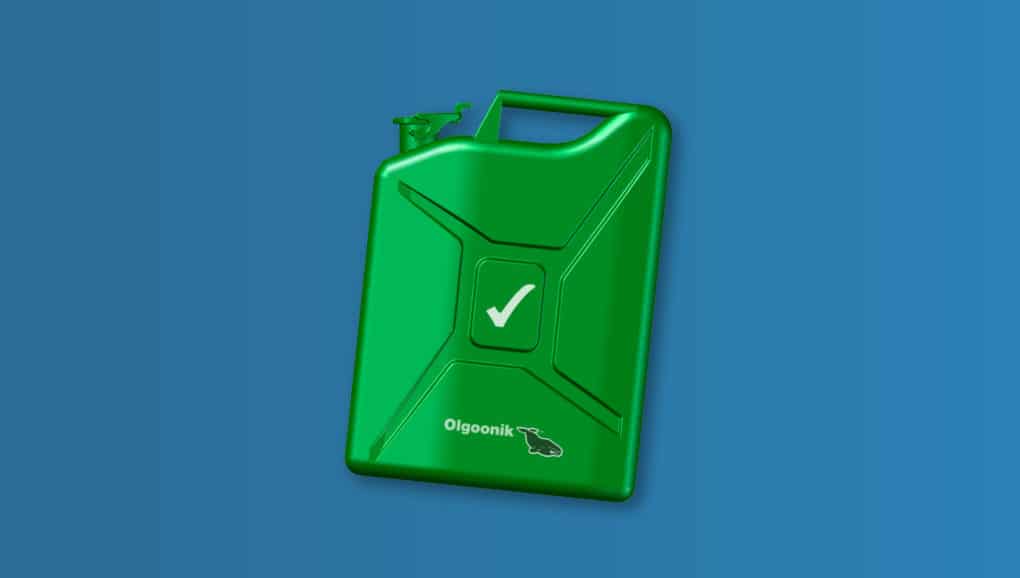WAINWRIGHT, AK – Olgoonik is the sole provider of gasoline to the community of Wainwright, Alaska. Similar to other North Slope Borough (NSB) villages, Wainwright fuel is procured from Eskimos Inc. and Crowley Marine Services. To ensure quality in our fuel supply, our employees are trained to follow rigorous protocols upon delivery, as well as ongoing regular inspections while fuel is in our tanks. We are proud to report that no water has been detected in any Olgoonik Holdings (OH) tank in the last three years.
The NSB divisional fuel manager, Allen Snow, says that before and after barge deliveries, Olgoonik employees act as witnesses for the NSB quality control measures, observing fuel quantity, fuel quality, and testing for water. “[The] 2021 gasoline barge delivery was completed August 30, 2021. Fuel quality test observed Specific Gravity 55.0@41.1 on Crowley Bill of Lading and 54.9@60* on [the] Eskimos Inc. Village Totals Sheet. No trace of water was observed on any of the reconciliation documentation provided by Eskimos Inc. and Crowley.”
To provide full transparency to our shareholders and community members, below is a list of safeguards and procedures for the Wainwright fuel supply:
Paperwork from the barge, before and after delivery – As stated by Allen Snow, this is witnessed by OH qualified persons, Crowley and Eskimos Inc. reps. No water has been detected in the last three years.
Current fuel tank dips – Our current contract with the NSB states we must give a detailed account for all fuel in Wainwright monthly. In order to do this, we check for water in the fuel every month.
On-site dispenser check – In the event we have a valid complaint, we check the fuel at the pump with water paste and have never found water at the pump.
Bulk tank sump for water removal – If we were to detect water in the bulk tanks, we could remove the water by draining a small amount of fuel from the bottom of the bulk tank to remove the water. Fuel is lighter than water so all of the fuel will be on top and the water will be on the bottom at the sump. This has not been required.
Pipeline water test out of low point – This is secondary action that could be taken if we were to find fuel in the bulk or day tanks. We would then check the pipeline for residual water after clearing any water from the bulk and/or day tanks.
Barge specific gravity test – The specific gravity or the weight of fuel is determined by its octane rating and if water is present in the fuel at the time of the barge delivery we do not accept the fuel.
Crowley test on the barge – Crowley maintains detailed records of fuel quality on the barge at loading and unloading. We check the fuel again and compare the quality of fuel to ensure we have not gained water during the delivery process.
10-micron filters – We change out our 10-micron filters every other month. Note the industry standard for remote fuel stations is to change them out two times per year, which is before and after the barge. 10 microns is .000394 inches. The human eye cannot see any particles that are smaller than 50-60 microns. Using this size of filter ensures we have no dirt and debris in the fuel.
Geometry of bulk tanks – The bulk tanks pull fuel about three feet from the bottom of the tank. In the 150,000-gallon unleaded bulk tank, there would have to be 23,900 gallons of water in our bulk tank before it would be pumped into our day tank.
Geometry of day tank – Day tanks have a discharge piping port to the dispensers at 10 inches off the bottom. To pump water to the dispensers, there would have to be 400 gallons of water in the day tanks.
In-line strainers – The fuel station has in-line strainers at the following locations. One before the transfer pumps in the pump room, one on the day tank located inside before the pump, and one in the dispenser before the meter and filter. This further ensures that we have clean fuel free of dirt and debris.
Physical proof to Wainwright public representative by appointment – Upon request from Wainwright community leaders, and by appointment, the fuel team will conduct a fuel quality test to ensure no water is present. Community leaders can make those test results available to the community.
For questions or comments, please reach out to us using the contact form linked here.
